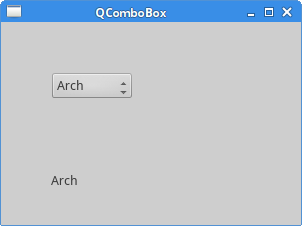PyQt6 widgets II
last modified January 10, 2023
In this chapter we continue introducing PyQt6 widgets. We cover
QPixmap, QLineEdit, QSplitter, and
QComboBox.
PyQt6 QPixmap
A QPixmap is one of the widgets used to work with images. It is
optimized for showing images on screen. In our code example, we will use the
QPixmap to display an image on the window.
#!/usr/bin/python
"""
ZetCode PyQt6 tutorial
In this example, we display an image
on the window.
Author: Jan Bodnar
Website: zetcode.com
"""
from PyQt6.QtWidgets import (QWidget, QHBoxLayout,
QLabel, QApplication)
from PyQt6.QtGui import QPixmap
import sys
class Example(QWidget):
def __init__(self):
super().__init__()
self.initUI()
def initUI(self):
hbox = QHBoxLayout(self)
pixmap = QPixmap('sid.jpg')
lbl = QLabel(self)
lbl.setPixmap(pixmap)
hbox.addWidget(lbl)
self.setLayout(hbox)
self.move(300, 200)
self.setWindowTitle('Sid')
self.show()
def main():
app = QApplication(sys.argv)
ex = Example()
sys.exit(app.exec())
if __name__ == '__main__':
main()
In our example, we display an image on the window.
pixmap = QPixmap('sid.jpg')
We create a QPixmap object. It takes the name of the file
as a parameter.
lbl = QLabel(self) lbl.setPixmap(pixmap)
We put the pixmap into the QLabel widget.
PyQt6 QLineEdit
QLineEdit is a widget that allows to enter and
edit a single line of plain text. There are undo and redo, cut and paste,
and drag & drop functions available for the widget.
#!/usr/bin/python
"""
ZetCode PyQt6 tutorial
This example shows text which
is entered in a QLineEdit
in a QLabel widget.
Author: Jan Bodnar
Website: zetcode.com
"""
import sys
from PyQt6.QtWidgets import (QWidget, QLabel,
QLineEdit, QApplication)
class Example(QWidget):
def __init__(self):
super().__init__()
self.initUI()
def initUI(self):
self.lbl = QLabel(self)
qle = QLineEdit(self)
qle.move(60, 100)
self.lbl.move(60, 40)
qle.textChanged[str].connect(self.onChanged)
self.setGeometry(300, 300, 350, 250)
self.setWindowTitle('QLineEdit')
self.show()
def onChanged(self, text):
self.lbl.setText(text)
self.lbl.adjustSize()
def main():
app = QApplication(sys.argv)
ex = Example()
sys.exit(app.exec())
if __name__ == '__main__':
main()
This example shows a line edit widget and a label. The text that we key in the line edit is displayed immediately in the label widget.
qle = QLineEdit(self)
The QLineEdit widget is created.
qle.textChanged[str].connect(self.onChanged)
If the text in the line edit widget changes, we call the onChanged
method.
def onChanged(self, text):
self.lbl.setText(text)
self.lbl.adjustSize()
Inside the onChanged method, we set the typed text to the label
widget. We call the adjustSize method to adjust the size of the
label to the length of the text.

PyQt6 QSplitter
QSplitter lets the user control the size of child widgets
by dragging the boundary between its children. In our example, we show three
QFrame widgets organized with two splitters.
#!/usr/bin/python
"""
ZetCode PyQt6 tutorial
This example shows
how to use QSplitter widget.
Author: Jan Bodnar
Website: zetcode.com
"""
import sys
from PyQt6.QtCore import Qt
from PyQt6.QtWidgets import (QWidget, QHBoxLayout, QFrame,
QSplitter, QApplication)
class Example(QWidget):
def __init__(self):
super().__init__()
self.initUI()
def initUI(self):
hbox = QHBoxLayout(self)
topleft = QFrame(self)
topleft.setFrameShape(QFrame.Shape.StyledPanel)
topright = QFrame(self)
topright.setFrameShape(QFrame.Shape.StyledPanel)
bottom = QFrame(self)
bottom.setFrameShape(QFrame.Shape.StyledPanel)
splitter1 = QSplitter(Qt.Orientations.Horizontal)
splitter1.addWidget(topleft)
splitter1.addWidget(topright)
splitter2 = QSplitter(Qt.Orientations.Vertical)
splitter2.addWidget(splitter1)
splitter2.addWidget(bottom)
hbox.addWidget(splitter2)
self.setLayout(hbox)
self.setGeometry(300, 300, 450, 400)
self.setWindowTitle('QSplitter')
self.show()
def main():
app = QApplication(sys.argv)
ex = Example()
sys.exit(app.exec())
if __name__ == '__main__':
main()
In our example, we have three frame widgets and two splitters. Note that under some themes, the splitters may not be visible very well.
topleft = QFrame(self) topleft.setFrameShape(QFrame.Shape.StyledPanel)
We use a styled frame in order to see the boundaries between the
QFrame widgets.
splitter1 = QSplitter(Qt.Orientations.Horizontal) splitter1.addWidget(topleft) splitter1.addWidget(topright)
We create a QSplitter widget and add two frames into it.
splitter2 = QSplitter(Qt.Orientations.Vertical) splitter2.addWidget(splitter1)
We can also add a splitter to another splitter widget.

PyQt6 QComboBox
QComboBox is a widget that allows a user to choose from a list of
options.
#!/usr/bin/python
"""
ZetCode PyQt6 tutorial
This example shows how to use
a QComboBox widget.
Author: Jan Bodnar
Website: zetcode.com
"""
import sys
from PyQt6.QtWidgets import (QWidget, QLabel,
QComboBox, QApplication)
class Example(QWidget):
def __init__(self):
super().__init__()
self.initUI()
def initUI(self):
self.lbl = QLabel('Ubuntu', self)
combo = QComboBox(self)
combo.addItem('Ubuntu')
combo.addItem('Mandriva')
combo.addItem('Fedora')
combo.addItem('Arch')
combo.addItem('Gentoo')
combo.move(50, 50)
self.lbl.move(50, 150)
combo.textActivated[str].connect(self.onActivated)
self.setGeometry(300, 300, 450, 400)
self.setWindowTitle('QComboBox')
self.show()
def onActivated(self, text):
self.lbl.setText(text)
self.lbl.adjustSize()
def main():
app = QApplication(sys.argv)
ex = Example()
sys.exit(app.exec())
if __name__ == '__main__':
main()
The example shows a QComboBox and a QLabel.
The combo box has a list of five options. These are the names of Linux distros.
The label widget displays the selected option from the combo box.
combo = QComboBox(self)
combo.addItem('Ubuntu')
combo.addItem('Mandriva')
combo.addItem('Fedora')
combo.addItem('Arch')
combo.addItem('Gentoo')
We create a QComboBox widget with five options.
combo.textActivated[str].connect(self.onActivated)
Upon an item selection, we call the onActivated method.
def onActivated(self, text):
self.lbl.setText(text)
self.lbl.adjustSize()
Inside the method, we set the text of the chosen item to the label widget. We adjust the size of the label.

In this part of the PyQt6 tutorial, we have covered QPixmap,
QLineEdit, QSplitter, and QComboBox.